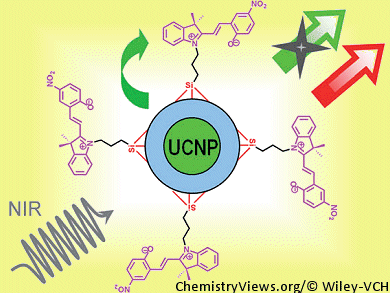Nanoparticles comprising an upconverting rare-earth fluoride core and a silica shell emit visible light after near-infrared irradiation. Such materials can be combined with photochromes, that is, molecules that change their molecular configuration reversibly in response to irradiation, to fabricate photoswitchable luminescence devices.
Chun-Hua Yan and colleagues, Peking University, China, used dual-emissive NaYF4:Yb,Er@CaF2 nanophosphors with a silica coating and a photochromic spiropyran derivative with a pendant Si(OMe)3 group to create a covalently grafted system. It exhibits highly efficient energy transfer, a high on/off switching ratio, and good durability.
When the photochrome is in the closed spiropyran form, the nanophosphor emits both red and green light (540 and 660 nm). UV irradiation converts the spiropyran to the open merocyanine form, which absorbs at 550 nm, thus quenching the green emission from the nanophosphor. Irradiation with visible light can then restore the spiropyran form and thus the green emission.
The red emission remained unchanged throughout the entire cycle, making it suitable as an internal reference, for example, to distinguish signal from background interference for practical applications like fluorescent labeling and detection.
- Photoswitchable Upconversion Luminescence of Rare-Earth Nanophosphors with Covalently Grafted Spiropyran,
Chao Zhang, Chun-Hu Xu, Ling-Dong Sun, Chun-Hua Yan,
Chem. Asian J. 2012.
DOI: 10.1002/asia.201200446




